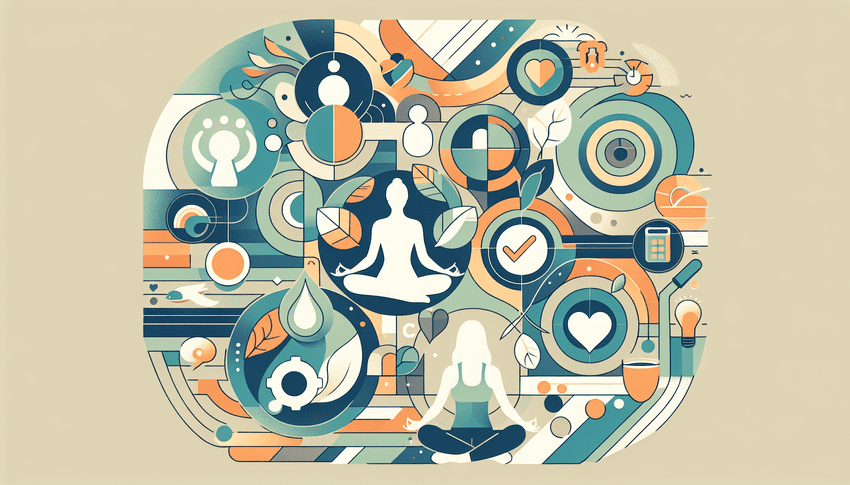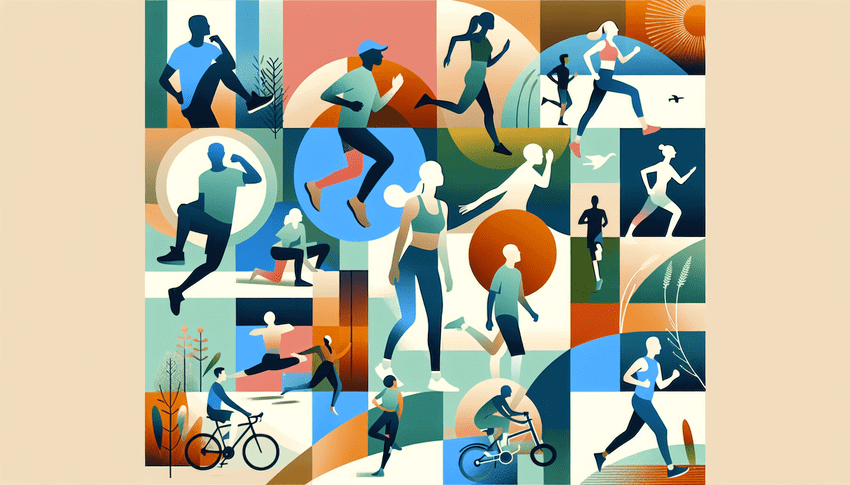Table of Contents
The Joyful Body

The Runner’s Euphoria: Physical Activity as a Path to Happiness
Exercise and Mood have a well-documented connection, with physical activity known to significantly enhance emotional well-being. When we engage in systematic exercise like running, cycling, or even brisk walking, the body responds by releasing powerful chemical substances, where endorphins are particularly noteworthy. Often fondly referred to as the body’s own ‘feel-good’ hormones, these endorphins play a crucial role in creating what is popularly known as the ‘runner’s high.’
The ‘runner’s high’ is not just a myth; it is a reality rooted in our biochemistry. During vigorous physical activity, our bodies also boost the production of serotonin and norepinephrine – neurotransmitters that play an integral role in stabilizing our mood. The sensation of euphoria that follows rigorous exertion is, therefore, a natural and extremely beneficial side-effect.
- Individuals who run regularly report feeling less stress and anxiety.
- Engaging in moderate exercise a few times per week is shown to improve mood and energy levels.
- Long-term commitment to physical activity can contribute to sustained happiness and well-being.
Real-world impacts of exercise on happiness
Consider Sarah, a 35-year-old teacher, who incorporated running into her daily routine. Initially skeptical, she found that within weeks she felt more tranquil and upbeat. Exercise became her therapy, her private time to shed the day’s stress. Similarly, 50-year-old Mark credits his evening bike rides with lifting his mood and helping him maintain a more optimistic outlook on life. These are not isolated incidents. Such testimonials underscore the thesis that Exercise and Mood are intimately linked, with even small shifts towards a more active lifestyle reaping noticeable benefits.
Scientific research bolsters these individual stories, with numerous studies concluding that regular physical activity has comparable effects to antidepressants for individuals with mild to moderate depression. Furthermore, exercise offers additional health perks, cementing its place as a cornerstone of a balanced, happy life.
To conclude, the relationship between Exercise and Mood is one of the most positive, impactful, and accessible ways to enhance our day-to-day happiness. By tapping into the natural reservoir of ‘happiness hormones’ through consistent physical activity, we can all edge closer to achieving a more joyful, serene state of mind.
Long-Term Benefits to Mood and Mental Health
Understanding the links between Exercise and Happiness becomes increasingly important as we explore comprehensive approaches to mental well-being. The feel-good endorphins released during exercise are just the tip of the iceberg when it comes to the long-term benefits to mood and mental health that a lifestyle inclusive of Physical Activity Joy can offer.
Engaging in regular physical activity can be a powerful ally in managing and potentially reducing the symptoms of depression and anxiety. Moreover, Fitness and Emotional Health are intertwined in ways that science is starting to understand more deeply. By sticking to an Active Lifestyle, individuals can experience Benefits to mental and emotional health that persist over time.
Studies have illuminated the correlation between routine physical activity and alleviated symptoms of depression. While the action of movement itself promotes the release of endorphins and serotonin—neurotransmitters responsible for feelings of pleasure and well-being—the long-term effects go beyond biochemistry. Regular exercise empowers people with a sense of achievement, fosters social connections when engaged in group activities, and contributes to a healthier body image, all of which are integral factors in maintaining a positive mood.
Anxiety, like depression, can also see significant improvements through a consistent workout regimen. The ability of exercise to serve as a distraction from worrying is pivotal. When we focus on the rhythm of our steps during a jog or the technique required in lifting weights, our cognitive load shifts away from the cycle of anxious thoughts. Physical activity further helps to moderate the body’s stress response, making it an invaluable tool for individuals seeking Well-being through Exercise.
It’s clear that there is much to gain from incorporating fitness into one’s lifestyle for mood and mental health benefits. However, it’s essential for exercise to be a part of a comprehensive, individualized approach to mental health, particularly when dealing with clinical conditions. This might include therapy, medication, and supportive social networks, with exercise being one part of the holistic puzzle.
Regular physical activity is an empowering practice that not only can provide immediate joys but also contributes significantly to the long-term fortification of mental health. Whether it’s the calming effects of yoga, the high-intensity release of a spin class, or the meditative state induced by swimming, the pathways to an uplifted mood and a healthy mind are many and varied. By embracing the Active Lifestyle Benefits, we enable ourselves to tap into a sustainable, self-reinforcing cycle of improved mental health.
Lifestyle Modifications for Happiness Enhancement

Nature’s Embrace: The Therapeutic Effects of Green Environments
Exercise and Mood have a well-documented relationship—a symphony of endorphins and a cascade of stress-releasing chemicals that come alive when we engage in physical activity. Time and again, research has shown that adding the verdant touch of nature to our exercise routines can amplify these benefits, leading to what is often referred to as ‘green exercise’.
The Impact of Green Exercise on Emotional Well-Being
The concept of ‘ecotherapy’ or ‘green therapy’ taps into the restorative powers of the natural world to improve psychological health. Exercise within green environments has been recognized not just for its physical health benefits, but also for its capacity to decrease stress and increase overall happiness. In a study where participants engaged in walks within both urban and natural settings, results indicated a significant preference and uplift in mood for those who walked in nature. This underscores the unique therapeutic effects that natural landscapes have on our emotional state.
- The Science of Stress Relief
- Heightening of Positive Emotions
- Building of Emotional Resilience
When we immerse ourselves in greenery while exercising, our bodies respond by lowering cortisol, the stress hormone. This biochemical reaction contributes not only to alleviating anxiety but also to fostering a sense of peace and joy. In essence, nature’s embrace while we engage in Exercise and Mood enhancement works hand-in-hand to create a sanctuary for mental health restoration.
Enhancing Emotional Intelligence through Group Activities
Green exercise extends its benefits to the realm of Emotional Intelligence, particularly when performed in social group settings. Structured outdoor activities, such as team sports or group hikes, provide a fertile ground for enhancing key dimensions of Emotional Intelligence like empathy and social awareness. Sharing challenges and triumphs amidst the beauty of the outdoors can create powerful bonds and understanding between individuals.
Examples from recent community initiatives highlight this integration of physical and emotional development. For instance, community gardens have become hubs for not just Exercise and Mood elevation but also for nurturing social ties and collective well-being. Participants often report a heightened sense of community belonging and an improvement in interpersonal skills as they work together toward a common green goal.
In conclusion, Exercise and Mood are intrinsically linked, and when coupled with the therapeutic effects of green environments, this relationship is potentiated. Whether through solitary walks in the park or engaging in vibrant community sports, the green hue of nature’s backdrop can serve as a mighty ally in our pursuit of happiness and holistic well-being. By understanding and embracing the connection between green exercise and Emotional Intelligence, we open ourselves to a world where physical activity is not just a task we tick off but a joyful, enriching experience that nurtures both the body and the soul.
Dance Like Nobody’s Watching: Movement and Social Connection
Exercise and Mood are closely connected, and one particular activity that beautifully intertwines these aspects is dance. When we talk about dancing for wellness, we delve into a sphere where rhythm and movement catalyze emotional resilience and social bonds—key ingredients for a joyful life.
Dance is not only a workout for the body, but also for the mind and the soul. It is a language understood universally, breaking barriers and building bridges among people. The strong correlation between dance and improved mood is not anecdotal; it is grounded in science. Studies indicate that engaging in dance can release endorphins, the body’s natural feel-good chemicals, which elevate mood and reduce stress and pain.
Dance and Emotional Intelligence
But the benefits of dance extend beyond the rush of endorphins. By dancing with others, we enhance our Emotional Intelligence (EI). Not to be confused with cognitive intelligence, EI is our ability to understand and manage our own emotions, as well as to recognize and influence the emotions of others. In a communal dance setting, participants must navigate shared space, interpret nonverbal cues, and synchronize their movements with others—all of which strengthen EI.
- Empathy in action: Engaging in partner or group dances requires individuals to be attuned to their partners’ physical and emotional states, thus fostering empathy—one of the core components of EI.
- Self-awareness and control: Through dance, individuals can explore different emotions and learn to express them in a controlled environment, a practice directly linked to improved self-awareness and emotional regulation.
- Social skills: The collective nature of dance classes or events encourages interaction and cooperation, sharpening social awareness and relationship management skills.
Community, Culture, and Happiness
Beyond the psychological effects, dance fosters social connections by bringing people together within community and cultural frameworks. Traditional folk dances, energetic salsa nights, and even contemporary flash mobs are platforms for cultural exchange and communal enjoyment. Exercise and Mood are notably enhanced by such shared experiences, fueling a sense of belonging and social support that is fundamental to human happiness.
Communal dance activities also serve as a stage for individuals to build confidence and positively shift their self-image. By mastering new skills, celebrating varied body types, and moving together in solidarity, participants gain self-esteem and body confidence, further enhancing their overall happiness quotient.
When we talk about Exercise and Mood, dance exemplifies how physical activity can be both a fun way to stay healthy and a powerful conduit for social connectivity. It’s an art form that carries the potential to enliven spirits, foster communities, and instill cultural pride, all while cultivating the EI necessary for personal and collective wellbeing. So next time the music starts, allow yourself to ‘dance like nobody’s watching’ and feel the joy radiate from the inside out.
Summary
The connection between physical exercise and mood enhancement is one of the most significant findings in the field of Positive Psychology. This interplay paves the way for a natural boost in emotional well-being that is both enjoyable and scientifically backed.
When we engage in activities such as running, cycling, or brisk walking, our body releases endorphins, also known as the ‘feel-good’ hormones. These biochemical agents are at the heart of the ‘runner’s high,’ a well-documented sensation of euphoria that occurs during and after high-intensity exercise. But endorphins are not alone in this endeavor; neurotransmitters such as serotonin and norepinephrine also see a surge during physical activities, leading to mood stabilization and enhanced emotional states.
- Regular runners often experience decreased stress and anxiety.
- Consistent moderate exercise is correlated with improved mood and higher energy levels.
- Sustained physical activity is a cornerstone of long-term happiness and well-being.
Real-world impacts of exercise on happiness
Stories from individuals like Sarah, a teacher who discovered tranquility and uplift in her mood through running, and Mark, who attributes his evening bike rides to a positive outlook on life, reflect the profound effects of exercise on mood. Research lends further support, comparing the benefits of regular exercise to the effects of antidepressants in cases of mild to moderate depression.
Switching gears, yoga emerges as an exercise form that epitomizes the mind-body connection. It goes beyond simple physical activity by integrating controlled breathing and meditative practices into the movements, which can significantly uplift mood and alleviate symptoms of depression.
- Yoga can induce a ‘flow state’ where participants report heightened presence and contentment.
- Mindful breathing techniques in yoga can help reduce stress levels and promote relaxation.
- Meditation in yoga can sharpen Emotional Intelligence, aiding in emotion management and empathy.
Exercise and mood benefits are not limited to the confines of a gym or yoga studio. The burgeoning concept of ‘green exercise,’ which orchestrates physical activity in natural surroundings, promises an additional layer of mental health benefits.
The Impact of Green Exercise on Emotional Well-Being
Studies show that working out in green spaces like parks or nature trails can further reduce stress, increase happiness, and build emotional resilience. Engaging with nature while exercising augments the stress-relieving and mood-boosting effects that come with physical activity, leading to a more profound and holistic sense of well-being.
Bringing the community into the fold, group activities in green environments aid in developing Emotional Intelligence by fostering empathy, social awareness, and a sense of belonging. This is evident in initiatives such as community gardens, where group endeavors lead to emotional as well as physical rewards.
Dance, as another facet of movement-based well-being, remarkably intertwines body rhythm with emotional resilience. Dancing, particularly in a communal setting, is not just an effective physical exercise but also enhances Emotional Intelligence by promoting empathy, self-awareness, and social skills.
- Dancing with others reinforces empathy due to the attunement required with partners.
- It provides a controlled environment for expressing and regulating a range of emotions.
- The social nature of dancing sharpens interpersonal skills and fosters connections.
In the dynamic interplay between physical activity and emotional health, dance stands out as a culturally rich and socially engaging way to elevate mood and build connections.
Conclusively, the relationship between exercise and mood represents one of the most accessible avenues to enhance daily happiness. Whether it’s the discipline of yoga, the serenity of green exercise, or the communal joy of dance, these activities support Positive Psychology and Happiness in profound ways, establishing them as more than just exercise—they are a route to a more fulfilling life.
FAQ – The Role of Exercise in Happiness
How does regular physical activity influence the levels of neurotransmitters associated with mood and happiness, such as serotonin and dopamine, in the brain?
Regular physical activity has a dynamic influence on our brain’s chemistry, particularly on mood-enhancing neurotransmitters like serotonin and dopamine. Engaging in exercise stimulates the release of these ‘feel-good’ chemicals, enhancing our mood and promoting a sense of happiness and well-being. This natural boost not only uplifts us shortly after a workout but can also contribute to long-term positive mood changes, as consistent exercise is shown to help in maintaining higher levels of these beneficial neurotransmitters over time.
How does engaging in regular physical activity influence the levels of mood-enhancing neurotransmitters such as serotonin and endorphins in the brain?
Regular physical activity is a potent mood elevator, as it typically boosts levels of serotonin and endorphins, key neurotransmitters that play a significant role in our sense of wellbeing and happiness. When we exercise, our bodies increase production of these ‘feel-good’ chemicals, creating a natural high often referred to as the ‘runner’s high,’ which can lead to improved mood, decreased feelings of stress, and an enhanced sense of vitality in our daily lives.
How does regular physical activity influence the release of neurotransmitters associated with mood and happiness, such as serotonin and endorphins?
Regular physical activity stimulates the production and release of neurotransmitters like serotonin and endorphins, which are often referred to as ‘feel-good’ chemicals. These biochemicals boost our mood and overall sense of well-being, acting as natural mood lifters and painkillers. By engaging in exercise, we can help orchestrate a harmonious dance of these neurotransmitters that promotes happiness and alleviates stress, contributing to improved mental health and a joyful state of mind.




